Interviews & Reports
For Comfortable Living Space: Tategu-KoshimizuDestination: "Tategu-Koshimizu" in Ninomiya, Nakagun, Kanagawa Prefecture
Date: October 29, 2014
Translation by: Kenta Koshimizu, reviewd by Marina Izumi
Do you know of "Tategu?" Tategu collectively refers to wooden partitions of space such as shoji, paper sliding doors, husuma, which are thick paper sliding doors. They control the opening and closing of a house. The sliding door entrance in the Golden Hall of Horyu-ji Temple is said to be the oldest in existence.
In this interview, we heard from Koshimizu Shigeru, the 3rd representative of Tategu Koshimizu, about the history of tategu (joinery) and the profession of construction joiner. He also represents Tategu Koshimizu as its 8th architect and the 5th joiner, whose business started in Nakai and then moved to Ninomiya , Nakagun, Kanagawa Prefecture in 1910.
Transition from A Carpentry to A More Professional Joinery in Pursuit of Aesthetic Joinery
Originally, there was no distinction between a carpenter and a construction joiner, and carpenters were engaged in the work currently done by joiners as part of their job. As time went on, more beautiful tategu, joinery containing elements of art for drawing rooms came to be required by clients including farmers and merchants to entertain their customers. To study the techniques required, a group of carpenters tried to invent a new kind of door and specialized themselves from being carpenters to being joiners.
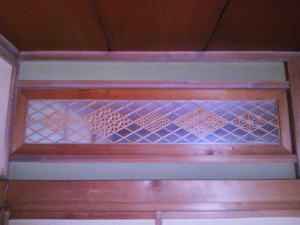
Partition Rama, Partition open-work frieze
Evolution as Integrating in People's Lives
"Tategu" has been evolving practically and artificially while becoming integrated in Japanese people's lives. For example, "senbon-goushi", whose name comes from its appearance of having a thousand fine grids, and "amado (rain doors)" served to prevent crimes in addition to its normal usage. Another example is that amado with an openable panel, "muso" in Japanese, enabled enduring the hotness of summer. In addition, partition ramma, partition open-work frieze (Pic 1) was developed to improve the circulation of air by ventilating smoke from a stove and has evolved creating a variety of designs of "Kumiko" a Japanese framework. "Nekoma shoji" was originally openable from side to side like eyes of a cat. In contrast, when it was brought to the Kanto Region, it became widely openable in up and down and renamed as "Nekoma Shoji of the Kanto Region (Pic 2)". A hexagonal pattern of Nekoma Shoji in the Kanto Region especially requires high-level of techniques and takes 10 days to make. Tategu is thus the sum of many efforts made by generations of joiners in developing their originality and techniques.
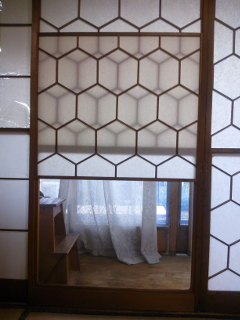
Pic.2 Nekoma Shouji of a hexagonal pattern in the Kanto Region(or snow‐scene viewing of hexagonal pattern)
The Real Pleasure of Being a Joiner
―When did you start this work?
I have worked as a joiner since I was 15. I have determined to be a joiner since I was born because my family had been a joiner for generations. In those days, there was my uncle, Hidenosuke, and 3 crafters who taught me the techniques. At that time, there were many requests for new buildings. We were really busy because we were requested to do 100~150 fittings per 1 building by hand. It took me almost 5 years to learn the techniques through many experiences. I have been engaged in this job for more than 50 years, but it is now that I feel fully qualified to be able to work efficiently or to select the best woods schemes understanding their specifics. The job feels even more interesting to me since now I can reflect my ideas on my work in terms of processing of woods or designs. Therefore, the job gets more and more rewarding and interesting.
Woods Carefully Selected
―What kind of woods do you utilize?
They are Japanese cedar, Japanese Zelkova, Japanese Cypress and spruce. We are restricted to use woods which are decades old to make joineries because young trees have a tendency of bending and curving. In the past, we usually used to use Japanese Zelkova (Sugi in Japanese). Sugi have a variation of color from pink to black depending on their growing district. Akita-Sugi in cold areas (Akita Prefecture) are popular and named "Red wood." Woods in cold areas are suitable for making joiners because they are especially stable. We pay close attention not to use woods called "Atteki," because of their non-suitable habits. Now, we usually use spruce from Alaska in a specialty store of wood for tategu.
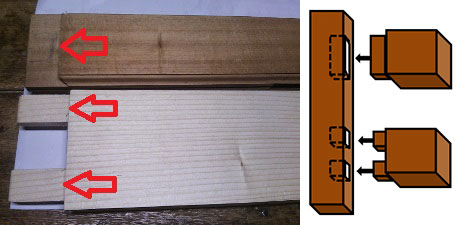
Pic.3 Top: Mortise before pulling out Bottom: Mortise after pulling out (Two step mortises)
Sturdy Tategu - Even Surprising to Joiners
―What is the biggest specialty of your work?
Tategu contains a binding with kern mortises, and mortise's holes (Pic 3 Red arrow shows mortises). If the binding is too loose, it is easily pulled apart. On the other hand, if the binding is too hard, woods will be is damaged. We have devised to increase more fitting strength of mortises by making two step mortises which withdraw between the mortise. It is especially in parts that cannot be seen at a glance that joiners put their originality. It was said that "Tategu made by Koshimizu are unbreakable" even when a carpenter throws them from the second floor to dismantle the house. As this episode shows, we make the strong fittings that can endure more than a few decades. Thus, the knowledge to keep a delicate balance of wood thickness and to select the wood position and fine adjustment of the mortise in order to make tategu long lasting and be attractive aesthetically, is what has been cultivated by experience over the years and this is the first priority of the enterprise. Because tategu are so long-lasting and sturdy, there is less order for us to repair or replace them. However, the enjoyment of using them for decades and the customers' attachment to them must be considered as the most important point.
Enjoy the Change of Space with Tategu
―Please tell us about the present market and expansion of the market in the future.
Most of our market is in architecture, real estate and private requests. There is a need for tategu in new building and restoration of old tategu as well. We have responsibility of follow-up on repairing tategu we built.
What we are now focused on the most is to propose and sell the creation of space by the use of tategu. Even changing tategu gives space a different atmosphere because tategu is outstanding of room. (Shown below, Pic.4 and Pic.5). I would like you to enjoy the change of space not just by replacing the door but using a different variation of door. Trees have many specific advantages. Trees are something like natural air conditioner; so it can get air and purify more air. Shoji is also an alternative to dehumidifiers that dries out wet air in the rainy season and an alternative to humidifiers which adds moisture in the dry winter. Consequently, we would like to inform you of the benefits of tategu and woods, and suggest adopting the tategu to your life.
This market also focuses on making tables and chairs by adopting the technology of tategu and expanding the market by making and selling Lampstand by kumiko style.
After The Visit
"Spend limitless time and effort" are important words cherished by Hanzo Koshimizu, who was the 1st representative of Koshimizu and was said to the best joiner in the Kanto Region. The Koshimizu family have inherited a desire to make better tategu with dedication over generation. I also realized the specialty of tategu seen in its invisible functions including the example of a mortise, which made me think that I would like to use them with fondness. I really hope that Mr. Koshimizu continues to make beautiful tategu and expose its beauty to many more people.
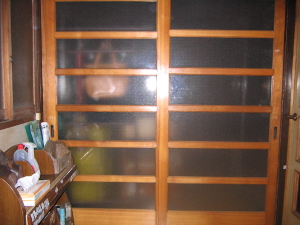
Pic.4 Before changing the sliding door
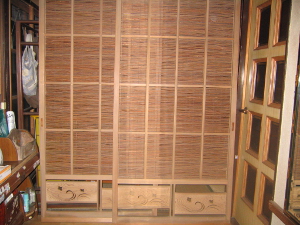
Pic.5 after changing the sliding doors
Tategu Koshimizu
921-1, Ninomiyama, Ninomiyamachi, Nakagun, Kanagawa Prefecture
259-0123
TEL: 0463-71-1333
FAX: 0463-79-5209
E-mail: tategu.koshimizu@bk2.so-net.ne.jp
Website : http://tategu-koshimizu.jimdo.com/




